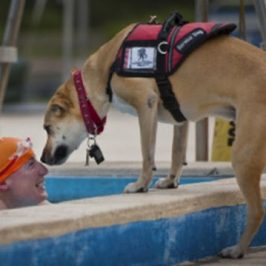
Service Dogs
First, lets hear it for all the dogs out there who assist people on a daily basis with personal physical issues, plus those dogs who provide support in hospitals and nursing homes. This article touches on the different types of service dogs and what they do.
At anytime in my life when I heard the words “dumb dog” whether on t.v. or from an actual person, I thought that I would just lose it. With all the things that dogs do when given the chance, I can’t imagine why anyone would question a dog’s intelligence.
We all know what a difference dogs make in the everyday lives of those of us without limitations. But, I wanted to share with you the difference that assistance dogs make in the lives of those with disabilities including special needs children.
From what I understand, there is a distinct difference between the categories according to the ADA (American With Disabilities Act of 1990):
- Therapy Dogs are trained to provide comfort and affection to those in nursing homes, hospitals, disaster areas, etc. These dogs do not have the same rights as Service Dogs.
- Service Dogs a.k.a. Assistance Dogs are trained to to provide assistance and perform tasks for a person with a physical or mental disability. However, according to servicedogcentral.org there were several key revisions made to the definition of “service dog” and “service animal” on July 23, 2010.
These furry helpers are so impressive!
The Different Categories
- Seeing Eye Dogs or Guide Dogs – These dogs are literally the eyes for the blind. They are trained to guide and navigate blind and visually impaired people, providing them easier access to the world around them. The most popular breeds that serve as seeing eye dogs are Labrador retrievers and Golden Retrievers. These dogs learn to ignore distractions, avoid obstacles and maneuver sidewalks, stairs and streets. According to the Americans with Disabilities Act, it is illegal to deny seeing eye dogs for the blind access to ANY public place. This holds true for Britain, Canada and most other countries as well.
- Signal and Hearing Dogs – Trained to assist the deaf by alerting them to a large range of sounds such as doorbells, smoke alarms, alarm clocks, timers, babies and even peoples names. Here’s and example of how the hearing dog signals his owner: If someone rings the doorbell, the dog will approach his owner, then run to the door alerting him that someone rang the bell or knocked. He will do this until his owner reacts to the sound. Yep, amazing!
Descubra o Sucesso nas Apostas LeoVegas Casino
Você já imaginou descobrir o segredo para o sucesso nas apostas de cassino? Seja você um jogador experiente ou alguém que está apenas começando, o LeoVegas Casino é o lugar perfeito para desvendar essa incógnita. Com uma ampla seleção de jogos emocionantes e uma reputação sólida no mercado, o LeoVegas Casino oferece uma experiência de apostas online incomparável.
Neste artigo, vamos explorar os principais pontos que fazem do LeoVegas Casino a escolha número um para aqueles que buscam o sucesso nas apostas. Desde a incrível variedade de jogos de cassino até as generosas promoções e bônus, vamos mostrar como o LeoVegas Casino pode levar suas apostas para o próximo nível. Então, prepare-se para mergulhar em um mundo de emoção e descobrir como alcançar o sucesso nas apostas com o LeoVegas Casino!
A história de sucesso do LeoVegas Casino: Descubra como esta plataforma de apostas se tornou líder no mercado.
Descubra o sucesso nas apostas no LeoVegas Casino, a plataforma líder em entretenimento de cassino online. Com uma ampla seleção de jogos emocionantes, desde caça-níqueis até jogos de mesa clássicos, você encontrará a experiência de jogo perfeita para satisfazer suas necessidades. Aproveite a conveniência de jogar a qualquer hora, em qualquer lugar, com o aplicativo móvel LeoVegas, disponível para dispositivos iOS e Android.
No LeoVegas Casino, você pode desfrutar de uma experiência de apostas online segura e confiável. Com uma licença de operação concedida pela Malta Gaming Authority, você pode ter a tranquilidade de que seus dados pessoais e transações estão protegidos. Além disso, o LeoVegas Casino oferece uma variedade de métodos de pagamento seguros e rápidos, para que você possa depositar e sacar seus ganhos com facilidade. Junte-se à comunidade de jogadores satisfeitos e descubra o sucesso nas apostas no LeoVegas Casino hoje mesmo!
Estratégias vencedoras: Conheça as táticas e dicas essenciais para aumentar suas chances de sucesso nas apostas no LeoVegas Casino.
Descubra o sucesso nas apostas com o LeoVegas Casino. Se você está em busca de uma experiência de jogo emocionante e lucrativa, não precisa procurar mais. O LeoVegas Casino oferece uma ampla variedade de jogos de cassino online, desde caça-níqueis até jogos de mesa clássicos, para todos os gostos e preferências. Com gráficos impressionantes, efeitos sonoros envolventes e uma interface fácil de usar, o LeoVegas Casino proporciona uma experiência de jogo de alta qualidade.
Além disso, o LeoVegas Casino oferece promoções e bônus atrativos para seus jogadores. Com ofertas exclusivas, rodadas grátis e prêmios emocionantes, você terá a chance de aumentar seus ganhos e aproveitar ao máximo sua experiência de jogo. Com um suporte ao cliente eficiente e seguro, você pode ter a certeza de que estará em boas mãos enquanto joga no LeoVegas Casino. Então, não perca mais tempo, junte-se à comunidade de jogadores vencedores e descubra o sucesso nas apostas com o LeoVegas Casino.
Explorando a variedade de jogos: Descubra as opções de jogos disponíveis no LeoVegas Casino e como escolher os mais lucrativos.
Descubra o sucesso nas apostas no LeoVegas Casino, o destino perfeito para os amantes de jogos de azar. Com uma ampla seleção de jogos de cassino online, você encontrará uma variedade de opções emocionantes para satisfazer todos os gostos. Desde caça-níqueis clássicos até jogos de mesa tradicionais, há algo para todos os jogadores.
O LeoVegas Casino oferece uma experiência de jogo de alta qualidade, com gráficos impressionantes e efeitos sonoros imersivos. Além disso, a plataforma é fácil de usar, permitindo que você navegue facilmente entre os diferentes jogos disponíveis. Com a tecnologia móvel avançada, você pode desfrutar de todos os jogos do LeoVegas Casino em seu smartphone ou tablet, a qualquer hora e em qualquer lugar.
Além da incrível variedade de jogos, o LeoVegas Casino também oferece promoções e bônus emocionantes para aumentar suas chances de ganhar. Com rodadas grátis, bônus de depósito e outras ofertas especiais, você terá mais oportunidades de aumentar seus ganhos. Não perca a chance de descobrir o sucesso nas apostas no LeoVegas Casino e comece a jogar hoje mesmo!
Gerenciamento de bankroll: Aprenda a administrar seu dinheiro de forma inteligente para maximizar seus ganhos no LeoVegas Casino.
Descubra o sucesso nas apostas com o LeoVegas Casino! Se você está procurando uma experiência emocionante e lucrativa no mundo dos jogos de azar, não procure mais. O LeoVegas Casino oferece uma ampla variedade de jogos de cassino online, desde caça-níqueis até jogos de mesa clássicos, para atender a todos os gostos e preferências.
Com uma plataforma fácil de usar e uma interface intuitiva, o LeoVegas Casino torna a experiência de apostar online simples e conveniente. Além disso, o cassino oferece bônus generosos e promoções emocionantes para novos jogadores e membros existentes, aumentando suas chances de ganhar grandes prêmios.
Ao jogar no LeoVegas Casino, você também pode desfrutar de uma experiência segura e confiável. O cassino é licenciado e regulamentado, garantindo que todas as transações e informações pessoais sejam protegidas. Com uma equipe de suporte ao cliente disponível 24 horas por dia, 7 dias por semana, você pode ter certeza de que receberá assistência sempre que precisar.
O poder das promoções e bônus: Descubra como aproveitar ao máximo as ofertas exclusivas do LeoVegas Casino para impulsionar seus ganhos.
Descubra o sucesso nas apostas com o LeoVegas Casino! Se você está procurando uma experiência de apostas online emocionante e lucrativa, você veio ao lugar certo. Com uma ampla seleção de jogos de cassino de alta qualidade e uma plataforma fácil de usar, o LeoVegas Casino oferece a oportunidade perfeita para você testar sua sorte e ganhar prêmios incríveis.
No LeoVegas Casino, você encontrará uma variedade de jogos emocionantes, incluindo caça-níqueis, roleta, blackjack e muito mais. Com gráficos impressionantes, recursos inovadores e pagamentos generosos, cada jogo proporciona uma experiência imersiva e divertida. Além disso, o LeoVegas Casino oferece promoções exclusivas e bônus lucrativos para aumentar suas chances de ganhar. Não perca mais tempo, junte-se ao LeoVegas Casino hoje mesmo e descubra o sucesso nas apostas!
Em conclusão, o LeoVegas Casino oferece uma experiência de apostas online emocionante e recompensadora. Com uma ampla seleção de jogos de cassino, incluindo caça-níqueis, jogos de mesa e cassino ao vivo, os jogadores têm uma infinidade de opções para escolher. Além disso, o site é fácil de navegar e oferece um ambiente seguro e confiável para jogar. Com bônus generosos e promoções emocionantes, os jogadores têm a chance de aumentar suas chances de ganhar. Não perca tempo e junte-se ao LeoVegas Casino hoje mesmo para descobrir o sucesso nas apostas!
Hearing and signal dogs also have the same rights as guide dogs here in the U.S. and they are permitted in any public place with their guardian.
- Mobility Assistance Dogs – O.k., now these guys are really incredible too! They are trained to do things like push buttons, pick things up, pull wheel chairs, open and close doors, retrieve items, load and unload the washing machine, call an ambulance and many more tasks.
- Seizure Alert/Response Dogs – a.k.a. Medical Alert Dogs, these guys are trained to alert the person to an oncoming seizure. They are trained to respond by either staying with the person or getting help.
- Medical Alert Dogs – These support dogs are trained to alert to approaching medical problems such as heart attacks, seizures (as mentioned above), diabetic issues such as hypoglycemic and hyperglycemic attacks, panic and anxiety attacks, post traumatic stress attacks and more.
- Autism Service Dogs – These incredible assistance dogs can be a real blessing to those with autism and the parents of autistic kids. They can be trained to find help, keep kids from wandering into streets or traffic, alert the child when his name is being called, guide the child home should he become lost. Plus, the relationship between child and dog offers the capability of controlling outbursts such as anger, mood swings and aggression. www.projectchance.com shares great detail on how service dogs can help autistic children.
Do you have a dog that you think could be a therapy dog?










